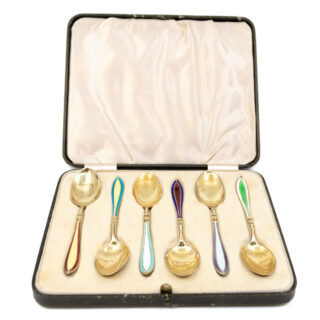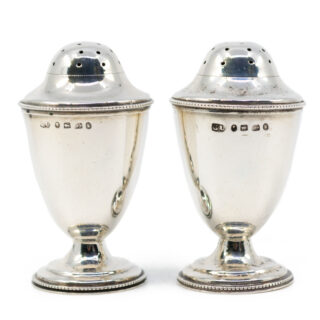Bring a vintage touch to any room with this gorgeous pair of silver convertible candlesticks from Gorham USA. Made from sterling silver, this charming pair is sure to add some classic charm to any space, dating from the years of 1935-1950! Gorham USA.
Details: Silver Candlesticks, Gorham USA *.
Design Era: Retro (1935-1950).
Dimensions: 23 x 11 cm.
Weight in grams: 1205 .
Condition: Good condition – used with some signs of wear.
Shipping and Pickup: This lovely piece ships from our store located in the center of Amsterdam, The Netherlands. We offer both registered shipping and local pickup at our store. In the case of local pickup, any applicable shipping costs will be refunded.
About Us: Add some sparkle to your style with Binenbaum.com. We offer a stunning selection of antique and vintage jewelry that you won’t find anywhere else. From timeless rings and dazzling necklaces to unique brooches, we have something for every taste and occasion. Visit our website today and treat yourself to a piece of history.
| Design Era | |
|---|---|
| Design & Historical Context | The jewelry industry was significantly impacted by the onset of World War II in the 1940s. Precious metals, particularly platinum, became scarce and in some cases were even banned from being sold. Palladium was used as a substitute for platinum in the war effort. In order to make the most of the limited supply of gold, a low karat gold alloy with a higher percentage of copper was used. This resulted in gold with a subtle, reddish hue, but through the use of different alloys, gold was able to appear in a range of colors within a single piece. Gold was also manipulated in various ways, such as being woven, braided, and coiled. Techniques like resilla, cannetille, and lacy filigree patterns reappeared in jewelry. Different textures were also used within a single design, with matte finishes being placed next to bright finishes to accentuate the design. Gold became the primary metal used in jewelry during the 1940s and 1950s. |
| Materials & Craftsmanship | Silver Silver is a white metallic element that is known for its excellent conductivity of heat and electricity. It is represented on the periodic table of elements by the symbol Ag, and it is a member of the noble metals, which are known for their excellent resistance to oxidation. Silver is a relatively soft metal, with a hardness that is intermediate between gold and copper. It is more malleable and ductile than gold, which means that it can be easily shaped and molded into various forms. However, it is not as hard as copper, which means that it is more prone to scratches and other types of damage. Because of its softness, silver is usually alloyed with another metal to harden it enough to maintain the desired shape and details when it is used in jewelry and other decorative objects. This helps to give it the necessary strength and durability for use in these types of applications. Throughout history, silver has played a prominent role in the production of jewelry and objets d'art. It is prized for its beauty and versatility, and it is often used in a wide variety of different types of jewelry, including rings, earrings, pendants, and bracelets. It is also used in decorative objects, such as candlesticks, vases, and other decorative items. |
| Dimensions | 23 x 11 cm |
| Gender | |
| Weight (in grams) | 1205 |
| Condition |
Enhance the Beauty of Your Jewelry with Proper Care
Wearing your jewelry is a special way to express yourself and add a touch of personal style to any look. However, to ensure your jewelry remains in pristine condition, there are a few simple steps you need to take to keep it looking its best.
General Care Instructions:
Remove jewelry when showering or bathing, especially when at the beach, in the sea or in chlorinated water.
Avoid wearing jewelry while doing physical work such as housekeeping, gardening or exercise.
Storing your jewelry in a dry and cool place will help protect it from moisture, dirt and dust.
Keeping it away from harsh chemicals such as bleach, ammonia and chlorine will help to avoid discoloration and damage.
Cleaning your jewelry regularly with a soft cloth will help to keep it looking shiny and new.
Avoid exposing your jewelry to extreme temperatures, such as leaving it in direct sunlight or near a heater, as this can cause damage.
Handle your jewelry carefully and avoid dropping it, as this can cause the stones to loosen or the metals to scratch.
Finally, if possible, have your jewelry professionally checked and serviced. This will ensure that any potential problems are spotted and fixed before they become worse.
By following these tips, you can enjoy your precious jewelry for many years to come.
Related products
-
Silver Oval-Shape Box 10583-2750
€ 395,00 VAT incl. (where applicable) -
Silver Wine Bottle Coaster 1424-1901
€ 650,00 VAT incl. (where applicable) -
Silver Antique Spoon Set 7913-2892
€ 450,00 VAT incl. (where applicable) -
Enamel Silver-Gilt Deco Spoon Set 8985-2642
€ 795,00 VAT incl. (where applicable) -
Silver Victorian Condiments 5262-2305
€ 895,00 VAT incl. (where applicable) -
Enamel Silver Silver-Gilt Guilloche Box 1427-1904
€ 795,00 VAT incl. (where applicable) -
Silver Judaica Hanukkiah 8656-2590
€ 2.895,00 VAT incl. (where applicable) -
Silver Set Of Salt And Pepper Shakers Set 7626-2460
€ 895,00 VAT incl. (where applicable)
- Home
- Collection
- Fine Jewelry
- Silver Jewelry
- Silverware
- Boxes
- Candlesticks
- Salt and pepper shakers
- Miniatures
- Salt cellars
- Spoon Set
- Condiments
- Frames
- Napkin Ring
- Spoon
- Oddities
- Cups
- Vases
- Cutlery
- Serving Spoon And Cake Server
- Candlesticks
- Baskets
- Hanukkiah
- Spice Tower
- Yad
- Tea Set
- Sugar Castor
- Napkin Rings
- Wine Bottle Coaster
- Wine Stopper
- Tea Pot
- Jugs
- Rattles
- Hip Flask
- Miscellaneous
- Rings 💍
- About
- Contact






















